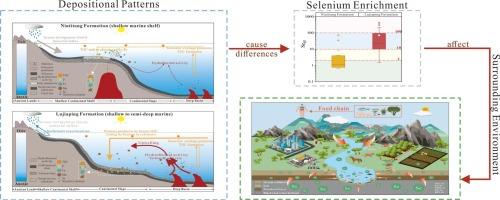西南下寒武统富硒黑色岩系:赋存模式及地表环境意义
IF 7.2
1区 地球科学
Q1 GEOSCIENCES, MULTIDISCIPLINARY
引用次数: 0
摘要
下寒武统黑色页岩普遍富集硒(Se),其易受风化作用,并可能向地表环境释放硒。然而,在不同的沉积背景下,硒含量、富集机制和赋存模式的变化及其对环境的影响仍然很不清楚。本文对华南地区下寒武统牛蹄塘组(浅海陆架)和陆家坪组(浅海-半深海)两个黑色页岩组进行了地球化学对比分析。陆家坪组硒含量(0.15 ~ 27.5 mg/kg,平均5.37 mg/kg)和富集系数(SeEF = 21.39)显著高于牛蹄塘组(0.14 ~ 7.37 mg/kg,平均1.02 mg/kg, SeEF = 1.10)。序列提取结果表明,牛蹄塘组硒主要以Fe-Mn氧化物结合(36%)、有机结合(32%)和残余(31%)形式存在,而陆家坪组以有机结合(66%)形式存在。根据风险评估准则(Risk assessment Code, RAC)进行的风险评估表明,牛铁塘样本全部为低风险(1%≤RAC < 10%),陆家坪样本13%为中风险(10%≤RAC < 30%)。陆家坪和牛蹄塘的次生与初生相比值(RSP)均为高污染潜势(RSP≥3)。牛蹄塘组硒主要来源于风化的陆源碎屑,在缺氧条件下沉积;陆家坪组硒主要来源于热液,缺氧和总有机碳(TOC)对硒的沉积均有影响。这些发现为研究早古生代海洋环境中硒的迁移和富集提供了新的思路,为评价风化黑色页岩富硒土壤的环境风险和可持续利用提供了科学依据。本文章由计算机程序翻译,如有差异,请以英文原文为准。

The lower Cambrian selenium-enriched black rock series in Southwest China: Occurrence modes and surface environmental implications
Selenium (Se) is commonly enriched in Lower Cambrian black shales, which are highly susceptible to weathering and may release Se into the surficial environment. However, variations in Se content, enrichment mechanisms, and occurrence modes across contrasting depositional settings remain poorly constrained, as do their environmental implications. This study presents a comparative geochemical analysis of two Lower Cambrian black shale formations in South China: the Niutitang Formation (shallow marine shelf) and the Lujiaping Formation (shallow to semi-deep marine). The Lujiaping Formation exhibits significantly higher Se concentrations (0.15–27.5 mg/kg; mean 5.37 mg/kg) and enrichment factors (SeEF = 21.39) than the Niutitang Formation (0.14–7.37 mg/kg; mean 1.02 mg/kg; SeEF = 1.10). Sequential extraction results show that Se in the Niutitang Formation mainly occurs in Fe-Mn oxide-bound (36 %), organic-bound (32 %), and residual (31 %) forms, while Se in the Lujiaping Formation is predominantly organic-bound (66 %). Risk assessment based on the Risk Assessment Code (RAC) indicates that all Niutitang samples pose low risk (1 % ≤ RAC < 10 %), whereas 13 % of Lujiaping samples fall within the medium-risk category (10 % ≤ RAC < 30 %). The Ratio of Secondary to Primary phases (RSP) reveals high pollution potential (RSP ≥ 3) in all Lujiaping samples and in 50 % of Niutitang samples. In the Niutitang Formation, Se is chiefly derived from weathered terrigenous detritus and deposited under anoxic conditions, whereas in the Lujiaping Formation, Se originates mainly from hydrothermal fluids, with deposition influenced by both anoxia and total organic carbon (TOC). These findings provide new insights into Se mobility and enrichment in early Paleozoic marine environments and offer a scientific basis for evaluating environmental risks and the sustainable use of Se-rich soils derived from weathered black shales.
求助全文
通过发布文献求助,成功后即可免费获取论文全文。
去求助
来源期刊

Gondwana Research
地学-地球科学综合
CiteScore
12.90
自引率
6.60%
发文量
298
审稿时长
65 days
期刊介绍:
Gondwana Research (GR) is an International Journal aimed to promote high quality research publications on all topics related to solid Earth, particularly with reference to the origin and evolution of continents, continental assemblies and their resources. GR is an "all earth science" journal with no restrictions on geological time, terrane or theme and covers a wide spectrum of topics in geosciences such as geology, geomorphology, palaeontology, structure, petrology, geochemistry, stable isotopes, geochronology, economic geology, exploration geology, engineering geology, geophysics, and environmental geology among other themes, and provides an appropriate forum to integrate studies from different disciplines and different terrains. In addition to regular articles and thematic issues, the journal invites high profile state-of-the-art reviews on thrust area topics for its column, ''GR FOCUS''. Focus articles include short biographies and photographs of the authors. Short articles (within ten printed pages) for rapid publication reporting important discoveries or innovative models of global interest will be considered under the category ''GR LETTERS''.
 求助内容:
求助内容: 应助结果提醒方式:
应助结果提醒方式:


